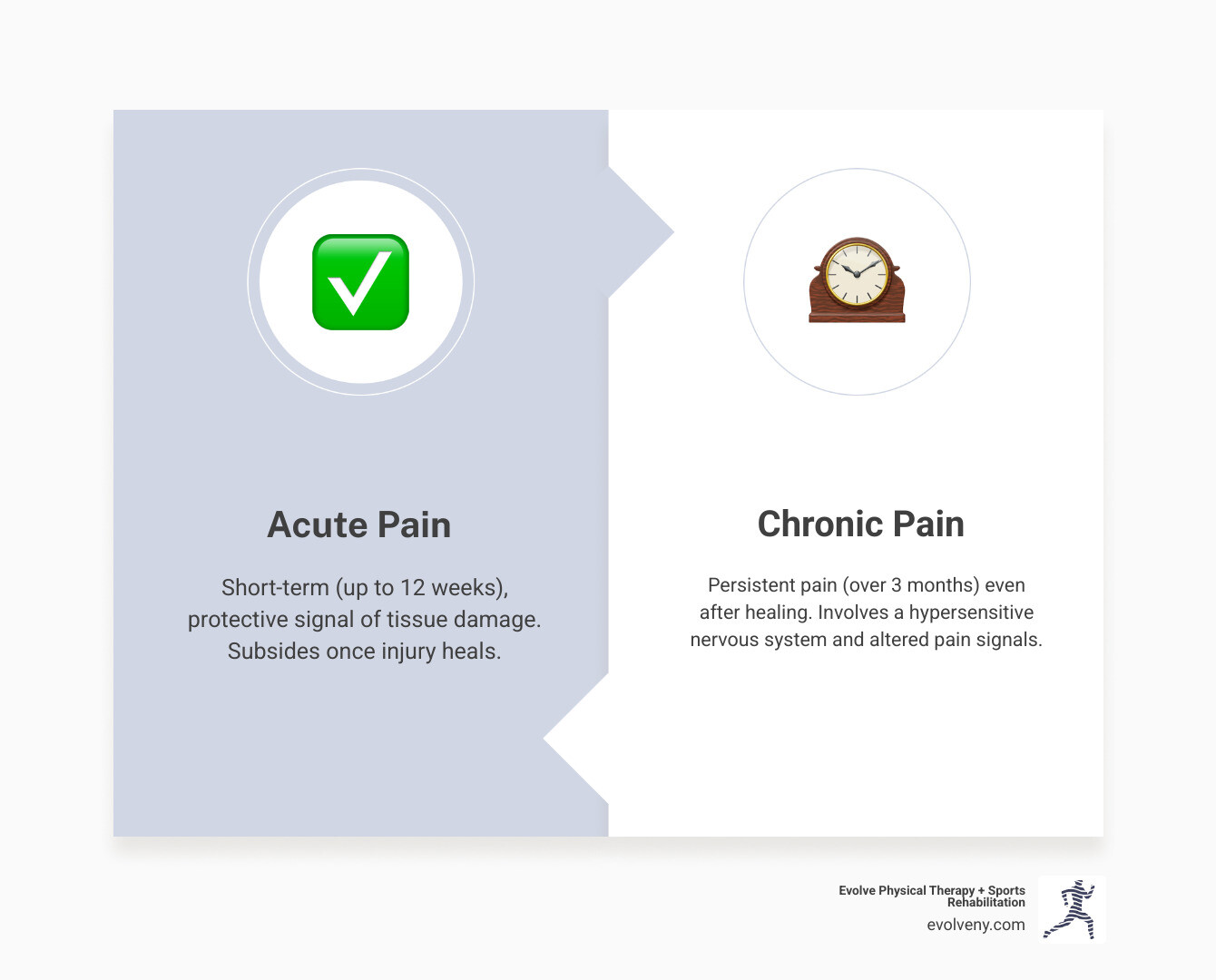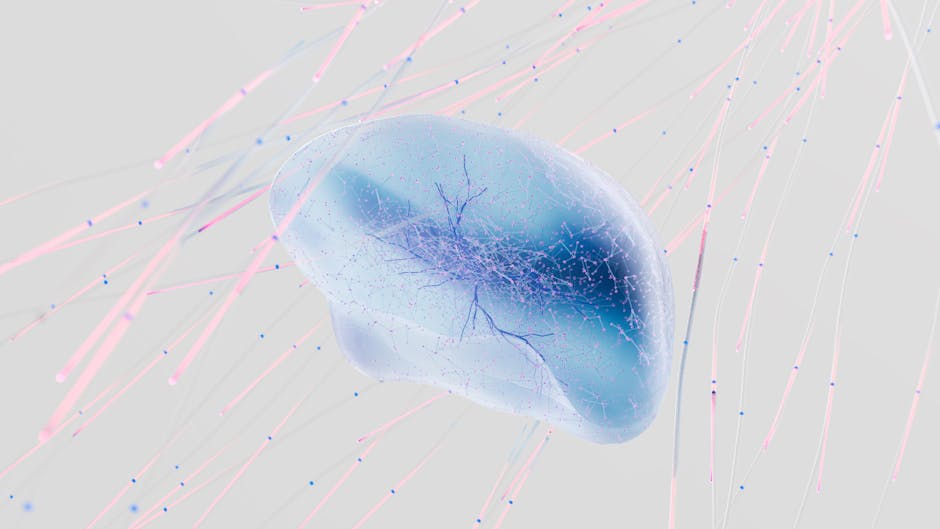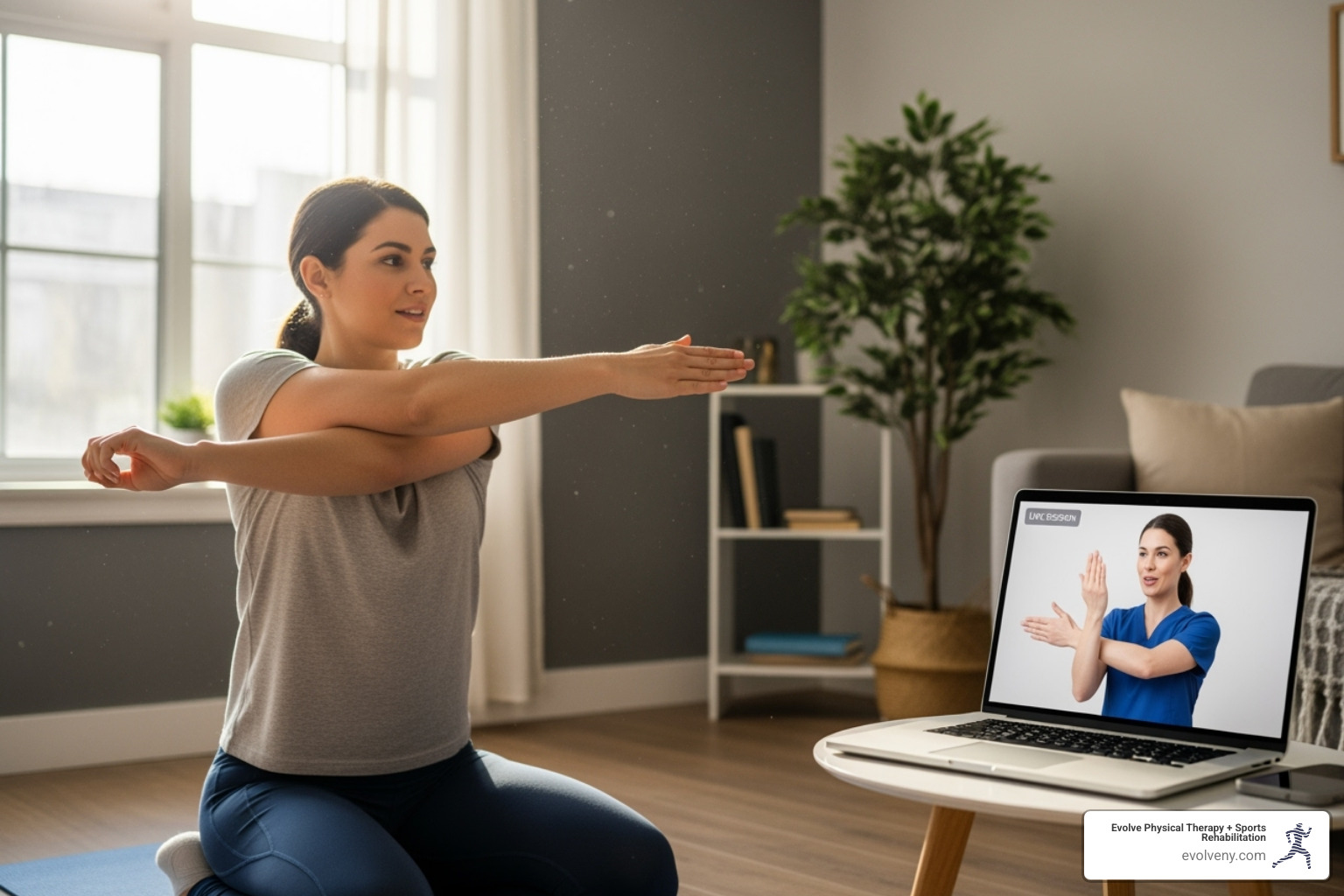Breaking the Pain Cycle – Physical Therapy Strategies for Chronic Pain
Why Physical Therapy for Chronic Pain is Your Path to Recovery

Physical therapy for chronic pain offers a proven, drug-free approach to breaking the cycle of persistent discomfort and reclaiming your active lifestyle. Here's what physical therapy can do for your chronic pain:
Key Benefits:
- Pain reduction through targeted manual therapy and therapeutic exercises
- Improved mobility and strength without relying on medications
- Education about pain science to reduce fear and anxiety around movement
- Personalized treatment plans addressing your specific condition and goals
- Long-term solutions rather than temporary symptom masking
Chronic pain affects nearly 51.6 million Americans, making it the leading cause of disability with an economic impact of over $560 billion annually. But there is hope—chronic pain doesn't have to control your life.
Unlike acute pain (a temporary alarm), chronic pain persists after tissues have healed because the nervous system becomes hypersensitive. Physical therapy excels at retraining your brain and body to break these faulty pain patterns.
Physical therapy addresses chronic pain through a biopsychosocial approach, recognizing that your pain experience involves biological, psychological, and social factors. Rather than simply masking symptoms, skilled physical therapists identify and treat the root causes of your discomfort while teaching you strategies to prevent future flare-ups.
I'm Lou Ezrick, founder of Evolve Physical Therapy. With nearly two decades specializing in physical therapy for chronic pain management, I've helped thousands of patients find lasting relief. My experience with complex cases confirms that with the right approach, recovery is achievable.

Understanding Chronic Pain: More Than Just an Ache
Acute pain is your body's alarm system, like the sharp pain from a burn that fades as you heal. It's a protective signal that typically resolves within 12 weeks.
Chronic pain is different. It's pain that lasts more than three months, persisting long after an injury has healed, as the nervous system continues to send pain signals. As the National Institute of Neurological Disorders and Stroke explains, while acute pain alerts you to injury, "chronic pain persists. Pain signals keep firing in the nervous system long after the injury has healed."
For example, ankle sprain pain that lasts six months instead of a few weeks is chronic pain, even if the original injury has healed completely.
This persistence is often due to central sensitization, where the nervous system's 'volume control' gets stuck on high. Your brain and spinal cord become hypersensitive, turning normal sensations like a gentle touch into pain.
The brain's role in pain is complex. Your brain actively creates your pain experience based on factors like past experiences, emotions, and stress. This is why stress can often worsen pain.
This is why we use the biopsychosocial model in physical therapy for chronic pain. We consider the biological (tissues), psychological (thoughts, emotions), and social (work, relationships) factors contributing to your pain. For instance, a person with chronic back pain may also have a fear of movement and anxiety about work, all of which are part of their pain experience.

Common Causes and Conditions
Chronic pain can develop from various sources, and understanding your specific situation helps us create the right treatment approach.
Previous injuries are common culprits. If an injury like a sprain or post-surgical recovery isn't fully rehabilitated, the nervous system can remain sensitized, turning acute pain into a chronic problem.
Arthritis affects millions with ongoing joint pain from inflammation and wear-and-tear. Physical therapy is proven to help people with osteoarthritis or rheumatoid arthritis improve movement and reduce pain. More info about Physical Therapy for Arthritis.
Fibromyalgia creates widespread pain, fatigue, and amplified pain signals in the brain. Our gentle, educational approach helps patients gradually and safely increase their activity levels. More info about Physical Therapy for Fibromyalgia.
Neuropathic pain results from nerve damage and creates sensations like burning, tingling, or shooting pain. Conditions like sciatica or diabetic neuropathy fall into this category.
Back and neck issues are among the most common chronic pain conditions we treat. Chronic low back pain was identified as the single greatest cause of "years lived with disability" worldwide, making effective treatment crucial.
How Chronic Pain Impacts Your Life
Living with chronic pain touches every corner of your life.
Physical effects create a frustrating cycle. Pain makes you move less, leading to deconditioning (weaker muscles, stiffer joints). This unfortunately can make you more susceptible to pain.
The emotional toll is immense, with about 67% of people with chronic pain also struggling with anxiety and depression. It's exhausting to hurt every day, and it's understandable to feel hopeless or irritable.
Social withdrawal often follows. You might cancel plans or avoid activities for fear of worsening the pain. This isolation can increase feelings of depression and anxiety.
The impact on work and daily activities can be devastating. Chronic pain is a leading cause of disability, affecting your ability to work, care for your home, or enjoy hobbies. According to a CDC study, over 20% of U.S. adults experience these challenges.
Physical therapy for chronic pain addresses all these impacts, helping you break the pain cycle and regain your life.
The Role of Physical Therapy for Chronic Pain
At Evolve Physical Therapy, we empower you to take control of your pain. Our approach to physical therapy for chronic pain begins with a comprehensive initial evaluation to understand not just where it hurts, but why.
During this diagnostic process, we'll discuss your history and daily routines, then perform a hands-on assessment of your posture, flexibility, and movement to find imbalances contributing to your pain. Unlike imaging like MRIs (which often show abnormalities in pain-free people), our evaluation focuses on your functional movement.
Together, we'll set functional goals that matter to you, whether it's sleeping through the night or hiking again. Your goals drive your treatment plan.
A powerful benefit of physical therapy is reducing your reliance on medication. By addressing root causes and teaching self-management strategies, we help you need fewer pain medications, avoiding their potential side effects and dependency risks.
Our ultimate goal is a genuine improvement in your quality of life. We want to help you reclaim the activities, relationships, and experiences that chronic pain may have stolen from you.

Goals of Physical Therapy for Chronic Pain
We partner with you to achieve several interconnected goals for lasting change.
Pain reduction is a primary goal. We use various techniques to calm overactive pain signals and provide significant relief.
Improved mobility follows as pain decreases. We work to restore fluid, easy movement in your joints and muscles.
Building increased strength and endurance is crucial. We safely help you rebuild physical capacity so daily activities become less taxing.
Restored function means getting back to what matters most, like playing with your grandchildren or working without constant discomfort.
We foster patient independence by teaching you to become your own best therapist, understanding your body and knowing how to manage flare-ups.
Finally, we focus on preventing future pain episodes. By correcting underlying issues and teaching proper body mechanics, we help break the cycle of recurring pain.
Key Interventions and Techniques
Our physical therapy for chronic pain toolkit includes a variety of evidence-based treatments personalized for you.
Manual therapy is a cornerstone of our approach. These hands-on techniques, including skilled joint mobilization and soft tissue massage, restore movement and release tension. This therapeutic touch helps retrain the nervous system's response to sensation. Research on manual physical therapy for chronic pain
Therapeutic exercise is medicine for chronic pain. We use graded exposure, starting with comfortable movements and gradually progressing. This desensitizes your nervous system and helps you overcome the fear of movement.
Our strengthening and flexibility programs blend low-impact cardio with targeted strengthening and stretching to address your specific needs. For those with back issues, these exercises can be life-changing. More info about Physical Therapy for Back Pain Brooklyn
We may also use modalities as supportive treatments. TENS units can help block pain signals, while heat and ice therapy relax muscles and reduce inflammation.
The key to our success is combining these approaches into a personalized treatment plan that evolves as you progress.
Your Partnership in Healing: Education and Active Participation
True healing from chronic pain is a partnership. We build a strong therapeutic alliance with you, based on trust and shared decision-making, where your goals and preferences shape your treatment plan. This collaboration is a powerful predictor of successful outcomes [Ferreira et al. 2013, Therapeutic alliance].
Your active role is paramount. Physical therapy for chronic pain is a process you actively participate in. Consistency with your home exercise programs is crucial for progress. Think of us as your coaches; we provide the roadmap and tools, but you're in the driver's seat.

Pain Neuroscience Education (PNE)
Pain Neuroscience Education (PNE) is a transformative tool where we teach you the biology of pain. Understanding that "pain does not always mean harm" is a crucial first step [Physiopedia]. Learning how your brain produces pain helps reduce fear of movement. This knowledge empowers you to re-engage in activities and change pain beliefs from "my body is broken" to "my nervous system is overprotective, and I can retrain it." PNE is a cornerstone of our approach to pain management and can greatly improve manual therapy effects Louw et al. 2017, A clinical perspective on a pain neuroscience education approach. More info about Pain Management in Brooklyn NY.
Behavioral Strategies for Managing Pain
We also equip you with behavioral strategies to gain control over your pain experience:
- Pacing Activities: Learn to balance activity and rest to avoid the "boom-bust" cycle. We teach you to break down tasks and take regular breaks to prevent pain flares.
- Goal Setting: We help you set realistic short-term and long-term goals, providing motivation and a clear path to recovery.
- Relaxation Techniques: Techniques like diaphragmatic breathing and progressive muscle relaxation help calm your nervous system and reduce muscle tension.
- Mindfulness: Mindfulness practices can help you observe pain without judgment, reducing the emotional distress associated with it and improving coping Hill et al. 2017, Changes in psychosocial well-being after mindfulness-based stress reduction.
- Improving Sleep Hygiene: We provide strategies to improve your sleep habits, as restorative rest is crucial for pain management.
- Stress Management: Since stress amplifies pain, we explore coping strategies to help you manage life's challenges without triggering flare-ups.
Integrating these strategies empowers you to become an active manager of your own pain, leading to greater independence and a better quality of life.
Advanced and Integrated Approaches to Pain Management
The best results in physical therapy for chronic pain come from a team approach. Each professional brings unique expertise to tackle different aspects of your pain.
At Evolve Physical Therapy, we regularly engage in collaboration with doctors and psychologists. This multidisciplinary care ensures we're addressing the physical, emotional, and social factors of your pain, not just the symptoms.
One of our most important roles is preventing the transition from acute to chronic pain. Early intervention with physical therapy can stop pain from becoming a long-term problem. By teaching proper movement and addressing fears about activity, we can interrupt the cycle that leads to chronic pain.
The shift in how we treat chronic pain represents a major breakthrough. We've moved from a purely biomedical model to a more effective biopsychosocial one.
| Feature | Biomedical Approach (Outdated) | Biopsychosocial Approach (Modern & Comprehensive) |
|---|---|---|
| View of Pain | Primarily a direct result of tissue damage or structural issue. | A complex experience influenced by biological, psychological, and social factors. |
| Focus of Treatment | Fixing the "problem" tissue; symptom suppression (e.g., surgery, medication). | Restoring function, reducing sensitivity, empowering self-management. |
| Patient Role | Passive recipient of treatment. | Active participant in their recovery. |
| Key Interventions | Medication, injections, surgery, passive modalities. | Exercise, education, manual therapy, psychological strategies, lifestyle changes. |
| Understanding of Healing | Pain resolves when tissue heals. | Pain can persist even after tissue healing; involves nervous system changes. |
This modern approach recognizes that you are an active participant in your recovery, and we are here to guide and support you.
The Impact of Technology in Physical Therapy
Technology is revolutionizing physical therapy for chronic pain, making treatment more accessible and effective.
Telehealth appointments offer incredible flexibility, eliminating travel stress and allowing us to see how you move in your own environment. This is particularly valuable for our patients with mobility challenges. More info about Physical Therapy for Neurological Disorders.
Virtual Reality (VR) for pain distraction is a powerful tool for pain management. By immersing you in a virtual world during exercises, it can redirect your brain's attention away from pain signals.
Wearable technology and app-based exercise programs help us track your activity, sleep, and response to exercises between visits. This data allows us to fine-tune your treatment plan and celebrate your progress.
Technology improves our partnership, empowering you to manage your pain while strengthening the crucial human connection in your healing journey.
Frequently Asked Questions about Chronic Pain and PT
We understand you have questions about chronic pain. Here are some honest, reassuring answers based on our experience.
How is chronic pain diagnosed by a physical therapist?
A physical therapist diagnoses chronic pain through a thorough evaluation. We start by listening to your story—your health history, the nature of your pain, and how it affects your daily life, sleep, and mood. Next, a physical exam assesses your strength and movement to identify patterns or imbalances contributing to your pain. These functional findings are often more revealing than an MRI. We don't rely heavily on imaging; instead, detailed questions about your symptoms and our physical assessment guide us to the factors crucial for your recovery.
Will physical therapy hurt?
This is a valid concern. The goal of physical therapy is to work within your comfort levels to reduce pain, not cause it. You might feel mild muscle soreness after some exercises—similar to after a good workout—but this is productive soreness, not harmful pain. We'll teach you the difference. We start slowly and progress gradually, never pushing you into sharp pain. Constant communication with your therapist is key. We are your partners in movement, and our goal is to build your confidence, not fear.
How long will I need physical therapy?
The duration varies for each individual based on their condition, the severity of the pain, and their personal goals. After your initial evaluation, your therapist will create a customized plan and timeline. Some patients feel better in a few weeks, while those with more complex conditions may need several months. Our ultimate goal is to empower you with self-management strategies. As you progress, you'll learn to handle flare-ups independently, and your visit frequency will decrease. The tools you gain will last a lifetime.
Take Control of Your Pain and Reclaim Your Life
I know how overwhelming chronic pain can be, making you feel trapped in your own body. But you have more power than you realize.
Physical therapy for chronic pain is about empowerment through movement and education. By understanding your pain and learning to retrain your body's responses, you become an active participant in your recovery.
I've watched thousands of patients reduce their pain levels, improve their mobility, and return to activities they thought were lost forever. These victories, big and small, are what matter.
Our approach is personalized, not cookie-cutter. We create personalized treatment plans that address your specific goals and work with your body's natural healing ability.
The importance of seeking expert care cannot be overstated. Chronic pain is complex, and you deserve guidance from professionals who understand the intricate relationship between your nervous system, movement, and pain experience.
At Evolve Physical Therapy + Sports Rehabilitation, our hands-on approach is designed to help you break the pain cycle and return to the activities you love. We combine evidence-based treatments with genuine care, giving you the tools and confidence for long-term success.
Your journey to better pain management starts with a single step. Relief is possible, and we're here to help you find it.
Begin your journey to a pain-free life with our physical therapy services.

